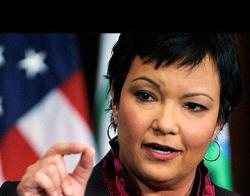
EPA Administrator Lisa Jackson
Last month, the Environmental Protection Agency (EPA) proposed a new standard on soot, small particles that cause a variety of unpleasant health effects. Now the Washington Post is reporting that the White House watered down the proposal behind the scenes:
EPA had originally wanted to tighten the annual exposure to fine-particle soot from 15 micrograms per cubic meter of air to 12 micrograms per cubic meter, according to an e-mail between Office of Management and Budget and EPA officials.
But OMB directed the EPA to make the limit between 12 and 13 micrograms per cubic meter of air.
The Post got hold of an email attachment [Word document] in which an OMB employee makes corrections directly to the EPA’s announcement.
What the EPA proposed as a reduction to 12 micrograms per cubic meter became “12 or 13.” A statement that the proposed change was based on scientific evidence was watered down to note that the proposed standard was “within the range” recommended. The Post:
White House spokesman Clark Stevens said OMB was in keeping with its mission when it “oversaw the interagency review process prior to the announcement of the proposal and worked closely with EPA to best assess feedback received through that process.”
Does this all sound a bit familiar? It should.
Last summer, the White House rejected EPA plans for a more restrictive rule on ozone pollution, prompting EPA Administrator Lisa Jackson to briefly consider resigning, though she “soon abandoned the idea as a futile gesture,” the New York Times reported.
It’s unlikely that Jackson will be similarly up-front about her dissatisfaction with this latest rollback. For one thing: The soot proposal is still an improvement. For another: It’s less than four months until Election Day.
Jackson’s in a difficult position. A scientist by vocation, she leads an agency constrained by politics at a time when her boss faces a close election. Shortly before Obama was inaugurated, Jackson pledged that science would guide the EPA’s decision-making — a promise that’s hard to keep once you’re in power.
Earlier this month, members of the EPA’s Science Advisory Board (SAB) sent a letter to Jackson [PDF] outlining the results of their study (sanctioned by Jackson) into how the EPA can strengthen the integration of science into its work. In its two dozen pages, the SAB suggests a number of ways the agency can adhere more closely to scientific principles and use science to guide decision-making. There’s one mention of politics: “The SAB acknowledges that other factors (such as law, politics, policy and values) play important roles … in agency decision making.”
For all of the 20-odd pages of the SAB’s report, it’s that one sentence that acts as trump card. The OMB’s revisions to the soot standard were not necessarily absent any consideration of science, just with a consideration for the political impact of what the science indicated. Politics relies on public will, and if even the EPA is still trying to figure out how to increase adherence to science, it’s unlikely that any president would feel bold in assuming that the public would understand a science-based decision.
Lisa Jackson sits at the overlap between scientific fact and political reality. It’s no wonder she thought about resigning.






